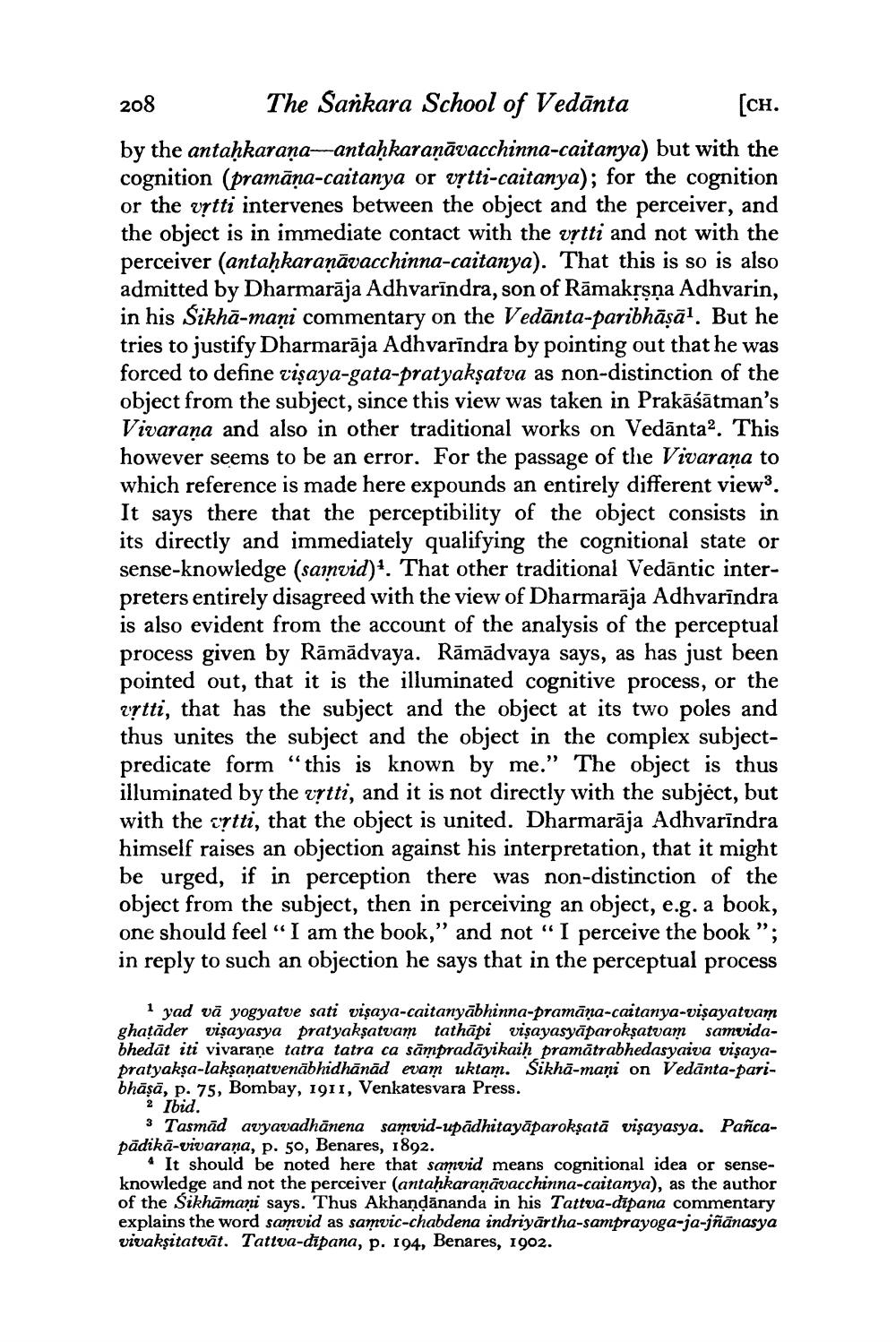________________
208
The Sankara School of Vedanta
[CH.
by the antaḥkaraṇa-antaḥkaraṇāvacchinna-caitanya) but with the cognition (pramāṇa-caitanya or vṛtti-caitanya); for the cognition or the vṛtti intervenes between the object and the perceiver, and the object is in immediate contact with the vṛtti and not with the perceiver (antaḥkaraṇāvacchinna-caitanya). That this is so is also admitted by Dharmarāja Adhvarīndra, son of Rāmakṛṣṇa Adhvarin, in his Sikha-mani commentary on the Vedanta-paribhāṣā1. But he tries to justify Dharmarāja Adhvarindra by pointing out that he was forced to define viṣaya-gata-pratyakṣatva as non-distinction of the object from the subject, since this view was taken in Prakāśātman's Vivarana and also in other traditional works on Vedanta2. This however seems to be an error. For the passage of the Vivarana to which reference is made here expounds an entirely different view3. It says there that the perceptibility of the object consists in its directly and immediately qualifying the cognitional state or sense-knowledge (samvid). That other traditional Vedantic interpreters entirely disagreed with the view of Dharmaraja Adhvarindra is also evident from the account of the analysis of the perceptual process given by Rāmādvaya. Rāmādvaya says, as has just been pointed out, that it is the illuminated cognitive process, or the vṛtti, that has the subject and the object at its two poles and thus unites the subject and the object in the complex subjectpredicate form "this is known by me." The object is thus illuminated by the vṛtti, and it is not directly with the subject, but with the crtti, that the object is united. Dharmarāja Adhvarīndra himself raises an objection against his interpretation, that it might be urged, if in perception there was non-distinction of the object from the subject, then in perceiving an object, e.g. a book, one should feel "I am the book," and not "I perceive the book "; in reply to such an objection he says that in the perceptual process
1 yad va yogyatve sati viṣaya-caitanyābhinna-pramāṇa-caitanya-viṣayatvam ghatader visayasya pratyakṣatvam tathāpi visayasyaparokṣatvam samvidabhedat iti vivarane tatra tatra ca sampradayikaiḥ pramatrabhedasyaiva visayapratyakṣa-lakṣaṇatvenābhidhānād evam uktam. Sikha-mani on Vedanta-paribhāṣā, p. 75, Bombay, 1911, Venkatesvara Press.
2 Ibid.
3 Tasmād avyavadhānena samvid-upādhitayāparokṣatā viṣayasya. Pañcapädikā-vivaraṇa, p. 50, Benares, 1892.
It should be noted here that samvid means cognitional idea or senseknowledge and not the perceiver (antaḥkaraṇāvacchinna-caitanya), as the author of the Sikhāmaṇi says. Thus Akhaṇḍānanda in his Tattva-dipana commentary explains the word samvid as samvic-chabdena indriyārtha-samprayoga-ja-jñānasya vivakṣitatvāt. Tattva-dipana, p. 194, Benares, 1902.




